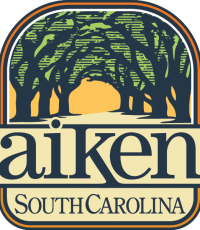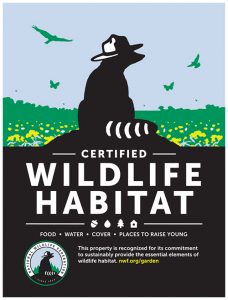Origins of Names of Trails, Waterways, and Places in the Hitchcock Woods
These names provide small, specific insights into the sweeping story of the Hitchcock Woods. Here for your enjoyment are brief synopses on the origins of the names seen on signs posted in the Woods, and on the many maps of the Woods that have been made over the years.
Special thanks to Courtney Conger and all of those who helped in researching this information.
Trails | Water Features | Places
1977 BURN: A lightning strike in 1977 caused a wildfire here that burned for over a month. In those days, fire was the enemy, and many volunteers patrolled the boundaries of the fire day and night to keep it from spreading to other parts of the Woods. Tiger Riviere was the main night watchman and he stayed up all night for about a month. The fire killed most of the trees, which were cut down and removed. Dr. William P. Bebbington was distressed by the carnage and blamed the Foundation, and especially Courtney Conger, for poor management. He called the area “The Conger Bald.”
Barton’s Pond Path: (alternately called The Path to Barton’s Pond) The reference to the early farmer Willie Barton is obvious. It dates back before the Hitchcock era and is mentioned on page 3 of Life and Sport in Aiken (hereinafter noted as L&SIA), published by the Derrydale Press in 1935.
Bear Pit Line: This is an original Hitchcock drag line (L&SIA, p. 44). The very first drag lines, Travers, Crazy Creek, Bear Pit, Bean, Turpentine Valley (also called Turpentine Still), Ridge Track, and Rabbit Valley (L&SIA, p. 44), were put in by members of the Axe Club (L&SIA, p. 45). The next drag lines, Brick Yard, Cuthbert Ridge, Queen Field, High Point, Juac Hollow, Skiddy, Turner Field, Cathedral Aisle, and Border (not current Border Line), were put in by “a band of woodsmen under Monroe Heath” (L&SIA, p. 45). Note that the Ridge Track was originally called just that. “Mile” must have been added later, making it the Ridge Mile Track.
Border Line Cut: This is not the original Border Line in the High Point area that was put in by the Hitchcocks in 1929-1930 (L&SIA, p. 45,). The new Border Line Cut was put in by the Foundation in the late1970s or early1980s as a firebreak and to mark the border between Bostwick property and the Hitchcock heirs’ land that was purchased by the Foundation in 1986.
Blue Ridge Ride: Originally called Blue Ridge Parkway, because the vistas were thought to resemble those of that famous drive, this trail was put in by Courtney Conger and Nancy Harrington on horseback with Namon Corley’s help in the 1970s.
Lucetta’s Ride: Many people thought that Mrs. Knox’s Ride was named for Lucetta, but it was actually named for Mrs. Helen Knox, her mother-in-law. Lucetta’s Ride was cut in the mid 1990s to honor her devotion to the Woods and to avoid confusion with the elder Mrs. Knox. It was an old skidder trail from one of the management thinnings of the Woods under former Forester Gary Burger. It was later turned in to a trail.
Cathedral Aisle: This trail is so named because the trees on both sides create the visual effect of the ribs of a gothic cathedral. An old railroad line, this path was the first rail-trail in the country to be recognized by the Rails-to-Trails Conservancy. The South Carolina Railroad & Canal Company built the raised rail bed in 1835 as part of its Hamburg-Charleston route. At the time, the 136-mile rail line was the world’s longest and was the domain of a steam locomotive named the Best Friend of Charleston. The tracks were already abandoned when the Hitchcocks purchased the land later in the century (L&SIA, p. 8).
Cavalry Charge: This probably was an original Hitchcock line. Researching.
Chalk Cliffs: This site and trail were probably called this by the locals and the name was continued by the Hitchcocks. It is mentioned as the “Chalk Hills” (L&SIA, p. 65). It is a very old vaucluse udorthent site.
Cleveland’s Line: This line is named in honor of Cleveland Heath, Woods caretaker for many years, after his accidental death in 1959 when a tree fell on him during clean-up of the Woods after Hurricane Gracie. The accident occurred on the Peek-a-Boo Lane about halfway between the Manage and Cathedral Aisle.
Coker Spring Road: This trail is named for Coker Spring Road, which leads to the trail from the winter colony and horse district. Coker Spring was once a source of Aiken’s water.
Corley Pass: This trail was named in honor of longtime Woodsman Namon Corley, who served as Woodsman for nearly 50 years, from 1959 to 2008.
Cuthbert Ridge Line: This line might have been named for Cuthbert Branch, a stream. It was an original Hitchcock drag line (L&SIA, p. 45).
Devil’s Backbone: An original Hitchcock trail, the Devil’s Backbone is the South Carolina Railway and Canal Company original railroad bed. The rail bed is closer to the Sand River “canyon” and some rails are visible in the eroded walls of the canyon. (Ninety Years in Aiken, South Carolina, written and published privately by Gaspar L. Toole II in the late 1950s or early 1960s, p. 9)
Doll Lane: This trail was named in the 1950s for Dolly Bostwick, a longtime trustee, land donor, and supporter of the Woods and, for many years, Master of the Aiken Hounds.
Foxes’ Den: Foxes’ Den was named by Mrs. Ewing who often had meets there. It was a very nice open place on top of the hill between the Ridge Track and Rabbit Valley.
Gravel Pit: Researching.
Harry’s Hill: Trail named for Dr. Harry E. Shealy, Jr., upon his retirement as Chairman.
Hastings Line: Probably named for Mr. and/or Mrs. Thomas (Helen) Hastings. He was a well known architect and they spent many winters here and built Horse Haven on Newberry Street. She was the main contributor to Memorial Gate in honor of Frank Hitchcock (L&SIA, p. 17). Hastings Line was built in 1928 and sponsored by Dr. John Todd and Mr. George Mead (L&SIA, p. 10).
Hepatica Trail: This small trail was hand cut on horseback by Courtney Conger and Nancy Harrington in the1970s. Namon and the tractor were not used for these narrow, fragile trails which also included the Low Country Ride and Kalmia Trail. This trail is named for the lovely hepatica, which blooms in late winter, although bloodroot is another wildflower that thrives there.
High Point Line: This was an original Hitchcock drag line (L&SIA, p. 45). This is the highest elevation in the Woods (approximately 525 feet) and some say in Aiken County, so the derivation is obvious.
Huber Cut: This area was surveyed by Huber Clay Company when they prepared to exercise their mining rights to Brick Yard Field. Friends of the Woods organized to fight the kaolin mining and through the negotiation of Alexander Sanders, then an environmental attorney, Mr. Huber agreed to accept 300 acres in fee simple on the other side of the bypass in return for the mining rights.
Juac (Jouac?) Hollow Line: Harry Worcester Smith in L&SIA spells it “Jouac.” It was possibly named for a spring by the same name that is still in existence on the other side of the bypass that was once the property of the Graniteville Company. This might be an early Indian name. It was an original Hitchcock drag line (L&SIA, p. 45).
Kalmia Trail: Hand cut on horseback by Courtney Conger and Nancy Harrington in the1970s to afford views of Kalmia on the hillside above the Horse Show Ring.
Lodge Ride: Lodge Ride was named after the Gamekeeper’s Lodge. It runs from the old house site and ties into Mrs. Allen’s Ride near Mrs. Allen’s Place.
Lovers’ Lane: This was originally a part of the Best Friend Railroad bed that ran through the Woods, parallel to Peek-a-Boo Lane, and probably so called by the Hitchcocks (L&SIA, pp. 1, 47). The original Lovers’ Lane was one of the first victims of Aiken’s stormwater damages. Courtney Conger participated in its demise out hunting with the Aiken Hounds in the late 1950s when the road bed gave way under her Thoroughbred mare, Esca Main. Esca gave a mighty lunge and landed on the far side of the washout, saving the day, herself and probably her rider! Parts of the original raised trail can still be seen from Peek-a-Boo Lane. Later, in the late 1960s or early1970s, Courtney Conger, Lucetta Knox, Nancy Harrington, Evna Allen and Patty Goodyear decided to resurrect the name and hand cut on horseback the new Lovers’ Lane on the Kalmia hillside between Peek-a-Boo and the Ridge Mile Track. A beautiful overlook, midway along the trail, is called “Lovers’ Leap.”
Low Country Ride: This was hand cut on horseback by Courtney Conger and Nancy Harrington in the1970s to access views of the steep hillsides draped with Spanish moss and overlooking the old Palmetto Golf Course irrigation pond (Horseshoe Pond).
Mr. Cooper’s Ride: This line was put in by surveyors in the 1970s to mark the border between newly developing Foxchase and the Aiken Prep School’s former woods. Fred Cooper, then a trustee, oversaw the surveying operation for the Foundation so the line was named for him. Woodsman Namon Corley followed Mr. Cooper with a tractor to create the trail.
Mr. Fletcher’s Ride: Cut in the 1980s to access the spectacular wild azaleas found in that area, this trail was named in honor of the late Harold A. Fletcher, longtime trustee, Aiken Prep School Headmaster, and father of Nancy Harrington. Sadly, the trail was found by visitors who took many of the azaleas, not knowing that they could not be transplanted from the wild.
Mrs. Allen’s Place (and adjoining Ride): This was named for Mrs. Evna C. Allen, daughter of an original Winter Colony resident, Everett Crawford, for whom the Crawford Fences are named. Evna grew up riding in the Woods with her father and sister, Molly C. Hopper, and continued to ride there until her death. She was a longtime trustee and resigned in protest when the Foundation began to perform management thinning (timbering for forest health) in the1980s.
Mrs. Ewing’s Ride: This ride was named for Mrs. Marjory Ewing, who was Aiken Hounds’ MFH in the late 1950s to mid 1960s.
Mrs. Knox’s Ride: This ride was named for Mrs. Seymour (Helen) Knox after her death.
Morgan Cut: This cut was put in by Courtney Conger and Namon Corley when the first pipe at Newman’s Cut washed out in the early 1990s. It is a quick and easy ingress and egress to the east side of the Woods from Coker Spring.
Newman’s Cut: This path was named for Walter Newman, longtime Aiken Prep School riding master. Before the Aiken Prep School stables (now The Stable on the Woods) were built, Mr. Newman kept his horses in the old Sandhurst Barn on DuPree Place (the barn site is now a subdivision) and used that trail to access the Woods with his students from the Prep School. There also was a steep trail down from DuPree to Coker Spring by the Girl Scout Hut, but that is gone now.
Nimrod Lane: This trail was named for John M. (Jack) Seabrook’s antique English road coach and in his honor upon his retirement as Chairman.
Old County Road: This name dates to the Hitchcocks or before and was certainly the road used by Willie Barton and his family to come and go from his farm, now called Willie Barton’s Place, and probably by the Heath family, which lived in the Gamekeeper’s Lodge.
Palmetto Ride: Put in by Sam Cothran during his tenure as Chairman with Namon Corley’s help, it is an extension of the Low Country Ride. No one knows where the Hitchcock Woods Foundation and Whitney Trust boundaries really are, but much of this trail is probably on Whitney Trust land. It has always been plagued by bogs and washouts, problems that continue to this day, but it is a lovely ride and well worth the efforts to save it.
Peek-a-Boo Lane: The original Lovers’ Lane ran parallel to and below Peek-A-Boo Lane. This afforded those traversing the upper trail the opportunity to “peek-a-boo” upon the lovers.
Pete bostwick trail: The trail from Memorial Gate to the Horse Show Ring was named for Pete Bostwick, a former trustee and famous polo player.
Pigeon Trap Loop: This name dates from the Hitchcock era. Live pigeon shoots were popular in the Woods in the 1920s and 1930s, as well as at the gun club called the “Shooting Club” at the end of South Boundary (L&SIA, p. 188). Clay pigeon shoots later took place near this drag line.
Pioneer Trail: This name was suggested by Sandy Tucker in honor of the Telephone Pioneers who replaced all of the old signs in the Woods with the new, routed signs seen throughout the Woods today. Sandy was then head of the Sign Committee and was the organizer of this monumental effort to replace over 100 signs in the 1990s.
Rabbit Valley: This was an original Hitchcock drag line (L&SIA, p. 44).
Ridge Mile Track: This is a very early, original track put in by Mr. Hitchcock to school his young steeplechasers (L&SIA, pp. 44, 114, 116). The first Aiken Hunt Steeplechase races were run over the regular drag lines in the Woods (L&SIA, p.103) and not on the track, which was used primarily for schooling young ‘chasers. The original name was simply the Ridge Track.
Riviere Ride: This trail was named for Scott Riviere by Nancy Herrington when he was an Aiken Prep student and an Aiken Hounds whip in the 1960s.
Route 66: Route 66, according to Nancy Harrington, was a joke made by Cal Huffines (APS ‘64) or Francis Jenkins (APS ‘58). Riders loved to leave the path at the site of the dwarf irises and pop over the log on the way to the path to the Horse Show Ring from Memorial Gate.
Smith Cut: This is another Hitchcock original named for Harry Worcester Smith (L&SIA, pp. 11, 44).
Surrey Trace: Euphemistically named by Nancy Harrington and Lucetta Knox for the path created by a new City sanitary sewer line, probably in the 1960s. The ladies were told that this was not a trail and that it was not to be ridden on. They did it anyway and the path is in use to this day.
Swampy Cut Line and Path: These were part of the sewer lines that went in with Surrey Trace and were named by Nancy Harrington and Lucetta Knox. The narrow paths became logging roads during the 1980s timber operation to fund the purchase of the Hitchcock heirs’ land. Swampy Cut was a water crossing, but the logging trucks created a boggy hole dangerous to horses and a bridge was later built to span it.
Tea Cottage Path: This is the original Hitchcock term for the path leading to the charming pavilion built by Miss Celestine Eustis in the 1920s (L&SIA, p. 61).
Todd Cut: This is another original Hitchcock line (L&SIA, pp. 11, 45). It was named for Winter Colony resident, Dr. John Todd of Montreal, who purchased “Sandhurst” in 1931 (L&SIA, p. 195).
Travers Line: This is an original Hitchcock drag line named for William Travers, early owner of “Rye Patch” and son of “Billy” Travers for whom the Travers Stake at Saratoga was named (L&SIA, p. 6).
Turtle Trail: This modest trail was hand hewn in the 1970s to afford Dr. I. Lehr Brisbin access to a particularly fertile box turtle area when he carried on research on turtles in this part of the Woods.
Whitney Drive: This long trail was named for Mr. William C. Whitney, who, with Frank Hitchcock and Thomas Hitchcock, jointly bought the 8,000 acres of land that formed the original Hitchcock Woods. At the death of Mr. Whitney, Frank Hitchcock bought his share from the estate and gave it to Mrs. Thomas Hitchcock (L&SIA, p. 8).
Willie Barton’s line: This original Hitchcock drag line was named for the former owner of the property.
Witch Hazel Ridge: This trail was put in by Courtney Conger, Nancy Harrington, and Harry Shealy with Namon Corley’s help. It provides access to Willie Barton’s spring and the cluster of late winter and early spring blooming witch hazels.
Wood Cut: Wood Cut was named for Mrs. William B. Wood, former Master of the Aiken Hounds, to get to and from the High Point Line from Barton’s Pond Bridge. There is a very steep hill and then a nice place to canter on the flat.
Bebbington Springs: This area is named for Dr. William P. Bebbington, who identified the many wildflowers found in the Woods.
Black Gum Pond: This pond dates from the Best Friend Railroad. It was the borrow pit for the raised rail bed that is now known as Cathedral Aisle. It probably was an early local name that was continued by the Hitchcocks. It is named for the many black gum trees that grow on the banks.
Calico Creek: This creek dates back to early Aiken and the Hitchcocks. The Clarence Dolans’ “Calico Cottage” probably was named for the creek (L&SIA, pp. 6, 7, 176).
Cathedral Aisle Swamp: This long narrow swamp was created by Sand River stormwater flow, Kalmia Hill stormwater flow, and the overflow from Black Gum Pond piped under Cathedral Aisle.
Coker Spring: Just outside the Woods, this simple monument was a source of early Aiken’s water. It is now being restored. The spring still flows into an old 1800s watering trough where horses may drink after a brisk exercise in the Woods.
Crazy Creek: This ephemeral stream dates back to early Aiken and the Hitchcocks (L&SIA, p. 46).
Cuthbert Branch: This stream dates to the Hitchcocks and is the name from which Cuthbert Track (now Mitchell Shopping Center) and Cuthbert Ridge were derived (L&SIA, pp. 45, 58).
Ghost Pond: This pond was formed from stormwater runoff overflowing the creek bed along Doll Lane in maybe the 1980s. In between stormwater flows, this mysterious pond can vanish.
Horseshoe Pond: This pond, located between Palmetto Ride and Low Country Ride, is the old irrigation pond for Palmetto Golf Course. The name comes from its shape.
Robinson’s Pond and Barton’s Pond sites: These old Aiken ponds were on the old Gregg estate purchased by the Hitchcocks (L&SIA, p. 3). The names almost certainly date to the 1800s and come from the early Aiken farmers who originally owned these lands and probably put in the ponds.
Sand River: The name probably dates even before the Hitchcocks (L&SIA, pp. 47, 65). Sand River is an ephemeral stream, which means that it flows only during and shortly after local rain events. In between the flow periods, only the dry, sandy riverbed is seen, hence the name. An interesting legend, handed down by American Indians who settled here, tells of an Indian princess who became ill and was about to die. The chief, who loved his daughter very much, was told in a dream to take her to the land of the rising sun where she would regain her health. The Indians built a stretcher for the princess and traveled eastward until they came to a land of whispering pines where a river of sand flowed. Here the Indians built a village, and the wonderful climate restored the health of the Indian maiden. This legend is recounted in Ninety Years in Aiken County on page 1.
Barton’s Pond Bridge: The original bridge was in the time of the Hitchcocks (L&SIA, p. 47). When the bridge deteriorated and became unsafe, the current bridge was built by the National Guard as a training exercise in the early 1980s under the supervision of Peter Gray.
Bluebird Hill / Nubbins Knoll: This was perhaps a nice spot for a bluebird family. Both names are modern day inventions and were given about the same time that loading decks were given their names. This site is called Nubbins Knoll in honor of former trustee Mrs. Helen (Nubbins) McKelvie at the request of her daughter, Mrs. Whitney Tower, after her mother’s death. Located by the Horse Show Ring, some have opined that it might be an Indian mound.
Bog Field: This describes several of the upland bogs that exist near High Point Line and Juac Hollow Line.
Brick Yard Field: Dating back to the Hitchcocks was Brick Yard Line (L&SIA, pp. 11, 47). Remnants remain of the 1800s brick yard just off Whitney Drive above the old Aiken Prep School stables.
Candy Field: This field is named for one of Mrs. William B. Wood’s horses. Mrs. Wood was Lucetta Knox’s aunt and was Aiken Hounds MFH. She lived in what is now the Green Boundary Club. The horse was Mrs. Wood’s bay mare, Candy.
Captain Gaylard’s Fences: This is named for Captain Gaylard, former Aiken Prep School riding master. “Sgt. William Gaylord (sic),” is mentioned as a former “Sergeant in the English Army, with his troop of youngsters … turning figure eights and becoming horsemen” (L&SIA, pp. 60, 73, 86, 92). They are one and the same, but Gaylard is the correct spelling.
Cathedral Aisle Fences: This lovely vista of fences is near and parallel to Cathedral Aisle. It dates back to the Hitchcocks and was then called Cathedral Drive (L&SIA, p. 58).
Dolan Hill: This is named for the Dolans, original Winter Colony residents (L&SIA, pp. 6, 36, 110, 171, 176).
Dove Field: The original Hitchcock-named Dove Field (L&SIA, p. 58) was near Turner Field and is also gone now. The new one is a former loading deck, which is a clearing made to accommodate log assembly in timbering operations.
Flicker Field: This is a former loading deck.
Fox Field: Researching.
Gail’s Crossing: Named for Gail B. King upon her retirement as Chairman.
Green House: This building at the end of South Boundary Avenue originally had only two rooms, a boot room and a laundry room for riders. It became a home for many families over the years and the house was expanded on various occasions. The name comes from the color of the exterior. After his service in the Navy, Huger Heath lived in the Green House. After Monroe Heath died, Sarah Heath moved into the Green House with her son, Huger. Alberta and Cleveland Heath remained at the Gamekeeper’s Lodge with their children. When Lila Lanier was 18, Alberta and Cleveland moved their family to the Green House so they could have electricity and city water. After Cleveland’s death, Alberta was allowed to continue living in the Green House by Mrs. G. H. (Dolly) Bostwick. She resided there for a number of years. The Green House was renovated in 2006 to serve as the Foundation’s first owned office.
Gamekeeper’s Lodge Hill: This is the site of the former Gamekeeper’s Lodge, which was home to the Heath family near Whitney Drive at the junction of Mr. Cooper’s Ride (L&SIA, p. 47). The Gamekeeper’s Lodge stood empty after the Heaths moved out. In the early 1970s, after continuously being vandalized, it was decided that the house should be razed to avoid a fire by arson.
Hawk Field: This is a former loading deck.
Hollywood & Vine: This is a recent, informal reference to the intersection of High Point Line, Todd Cut, and the power line, with an allusion to the famous intersection in Los Angeles.
Horse Show Ring: The Horse Show Ring was built and named by the Hitchcocks in 1916, the inaugural year of the Aiken Horse Show, which is given an entire chapter, “The Aiken Horse Show,” in Life and Sport in Aiken (L&SIA, pp. 76 – 82). The Horse Show Ring had to be moved to higher ground when the area flooded due to municipal stormwater.
Jack Rabbit Field: This name dates to the Hitchcocks. Mrs. Hitchcock imported jack rabbits from the west to hunt with her Beagle pack (L&SIA, pp. 8, 65).
Lee Field: Researching.
Martin Field: Martin Field dates to the Hitchcocks (L&SIA, p. 10), perhaps for Mr. Hitchcock’s valet of 50 plus years, Lewis Martin. Other Martins mentioned in Life and Sport in Aiken were two Aiken Prep School boys who were members of the “Meadowlarks,” Mrs. Hitchcock’s children’s polo team.
Memorial Gate: This Aiken landmark dates from 1926. “A memorial wall built of brick and surmounted with Italian marble has been erected by Mrs. Thomas Hastings and twenty friends at the north entrance to the Hitchcock Woods in memory of Francis R. Hitchcock” (L&SIA, p. 17). For many years, this was the official entrance to the Woods from Devil’s Backbone, until lands owned by Dolly Bostwick later became Foundation property.
Mockingbird Hill: This is a former loading deck.
Mr. Crawford’s Fences: This schooling area is named for an original Winter Colony resident, Everett L. Crawford, of New York (L&SIA, pp. 7, 104, 160, 192).
Mrs. Allen’s Place: This is named for Mr. Crawford’s daughter. See also Mrs. Allen’s Ride.
Mystery Field: The Hitchcocks’ first grandchild, Julian Peabody, reports that one of Mrs. Hitchcock’s hounds chased something “mysterious” to this place, hence the name.
Nursery Field: This name dates to the Hitchcock era. According to one source, young pines from this field were used for jumps in the Woods, thus the name Nursery Field. Another source reports that this is where the nannies looked after the children while the parents were foxhunting.
Nuthatch Hollow: This is a former loading deck.
Owl Outlook: This is a former loading deck.
Peter’s Point: This location is named for Peter L. Gray upon his retirement as Chairman.
Pileated Patch: This is a former loading deck.
Poke Berry Patch: This is a former loading deck.
Quail point: This is a former loading deck.
Red Cliffs: This location is another very old vaucluse udorthent site in the Woods, this one strikingly red in color. The name dates before the Hitchcocks.
Sam’s Overlook: This site was named for Sam Cothran upon his retirement as Chairman.
Tea Cottage site: The Tea Cottage was built, probably in the 1920s, by Miss Celestine Eustis for tea time after the hunt. Many events were held at the “large piazza” with “fire boards on top of posts” and “great bon fires” as well as the “greasy pig” (L&SIA, p. 61). The building burned twice and was rebuilt once. The second building was burned by vandals in the 1970s. Parties at this site continue to be held to the present day by Aiken Hounds and Aiken Prep School.
Tim’s Crossing: This site was named for Timothy W. Simmons upon his retirement as Chairman.
The Manage: This originally was Captain Gaylard’s “Manage” and is pronounced as the verb “to manage.” Captain Gaylard used the deep sand to quickly tire a fresh horse and make him more “manageable.”
Valley of the Magnolias: This area was hand cut on horseback by Courtney Conger and Nancy Harrington in the 1970s to access the views of the steep hillsides above Doll Lane. Douw Meyers, then an Aiken Prep School Master, was the “surveyor” for the trail. It was unnamed until a wooden sign with the words “Valley of the Magnolias” mysteriously appeared on the path. Mrs. Allen and Mrs. Hopper, who rode together in the Woods every day possible accompanied by their groom, John, called the area “Millbrook” because it reminded them of their home country in Millbrook, New York.
Warbler Ridge: This is a former loading deck.
Whisper & Ruby’s Place: This site was named by Nancy Harrington for two of her favorite hounds when she was Aiken Hounds MFH. The two hounds got into a memorable fight there and Nancy commemorated the battle.
Willie Barton’s Place: See Willie Barton’s Line.
Yucca Valley: This hollow is named for a beautiful cactus with a beautiful “bayonet” of white blooms in the spring.





